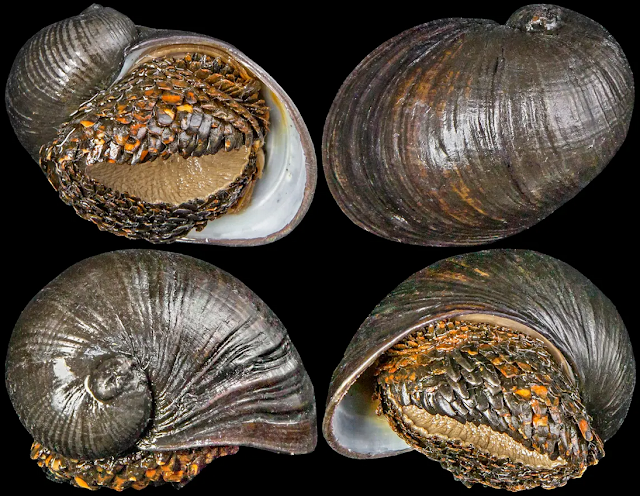The bizarre scaly-foot snail, (Chrysomallon squamiferum) or sea pangolin.
A snail with a foot clad in iron scales seems like a creature from science fiction. But in a few remote spots of the Indian Ocean these snails are very real. The bizarre scaly-foot snail, or sea pangolin.
The snails’ habitat is extreme. They live several miles below the ocean surface on searing hydrothermal vents, which are bathed in toxic chemicals and can reach temperatures of more than 572F.
The snails’ entire bodies and lifestyles revolve around bacteria growing inside a special pouch in their throat, which convert chemicals pouring out of the vents into energy and thereby provide all the snails’ food.
To keep their microbes well fed, scaly-foot snails evolved enormous gills to absorb oxygen and chemicals from seawater, then deliver it by way of their bloodstream and a hugely capacious heart. A human heart of equivalent proportions would be the size of our heads.
In 2019, scientists worked out that the scales on the snails’ foot are not to protect against predatory attack but to avert a toxic threat that comes from within. The bacteria stashed in a scaly-foot snail’s throat release sulphur as a waste product, which is deadly to snails (it’s a common active ingredient in slug and snail-killing pellets).
The internal structure of their scales acts as tiny exhaust pipes, drawing the dangerous sulphur away from the snails’ soft tissues and depositing it as a harmless iron-based compound on the outside.
Unfortunately for the scaly-foot snail, all three sites where they live, an area of less than 0.01 sq. miles, are potential targets for deep-sea mining.
Mining firms are after the gold, silver and other precious or rare metals deposited in the rocky walls of the black smoker chimneys. If their tiny areas of habitat are damaged or destroyed, the scaly-foot snails would soon be gone.
That’s why Julia Sigwart, a biologist at Frankfurt’s Senckenberg Research Institute, and her team set about assessing the status of these rare animals and eventually had the scaly-foot snail added to the International Union for the Conservation of Nature’s red list as an endangered species.
“It’s an incredibly powerful communication tool,” she says. “When you say a species is endangered, everyone in the world understands that.”
The scaly-foot snail was the first species in the world to be listed as threatened because of deep-sea mining but there are now many deep-sea mollusks that experts have assessed and added to the global endangered list.
Out of 184 endemic species that only live on vents, from giant clams to fuzzy snails, only 25 are not considered to be at risk of extinction.
These species remain relatively secure, Sigwart explains, because they live on vent fields where there is an explicit ban on any future development of deep-sea mining. This includes marine protected areas in territorial waters of Canada and around the Azores.
Most of the other species live on hydrothermal vents out in the high seas, which are beyond territorial limits and therefore less protected and more open to mining exploration.






No comments:
Post a Comment